Events of Saturday afternoon, 8th November 2014
Big Bus Tours offer hop-on, hop-off sightseeing tours at a number of cities around the world. Rita and I discovered that Vienna has not one but two routes served by Big Bus Tours and we decided that, with our limited time, this would be a good way of seeing more of the city. Big Bus Tours provide more details of the Vienna routes here and you can find a map of Vienna showing both the Red Route and Blue Route here. A few minutes walk from our hotel along the pedestrian shopping street Karntnerstrasse took us to the Opera House and, in one of the side streets nearby, Walfischgasse, we found the waiting Red Route Big Bus. We set off a few minutes later, taking Schwartzenbergstrasse to the junction with the impressive Ringstrasse.
Until 1817, the old parts of the city were protected by defensive walls but, over the next thirty years, the walls were removed and a broad road was constructed on the site forming the Ringstrasse. New, elegant buildings appeared along the Ringstrasse, encouraged by the interest of successive Hapsburg Emperor's in art, culture and music. Vienna became a unique and impressive city, a fact recognised by Vienna being added to the World Heritage List compiled by the United Nations Educational, Scientific and Cultural Organisation.
We crossed the Ringstrasse with its complex tramway junctions and entered the broad Schwartenplatz with its equestrian statue in the centre and, on our left, the Palais Archduke Ludwig Viktor. I noticed that the elevation facing the Ringstrasse is now a branch of T.G.I. Friday's. Our bus then turned right, leaving the fountain and the colonnade of the Soviet War Memorial on our left.
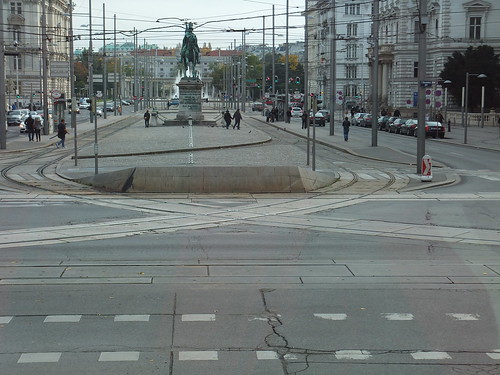 Schwartzenbergplatz with its equestrian statue looking towards the fountain and the colonnade of the Soviet War Memorial.
Schwartzenbergplatz with its equestrian statue looking towards the fountain and the colonnade of the Soviet War Memorial.
We passed the famous concert hall, the Musikverein and, in the park on our left, two striking railway station buildings, now without a railway, built in 1898 as Karlsplatz station of the Metropolitan Railway. The architect was Otto Wagner and protests managed to save these buildings from demolition.
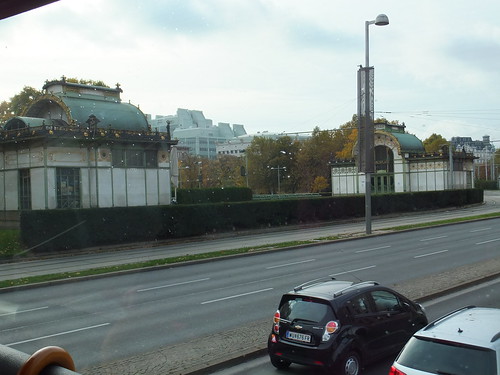 The preserved Karlsplatz station buildings.
The preserved Karlsplatz station buildings.
The bus turned right into Karntnerstrasse to join the Ringstrasse. Each section of the Ringstrasse has its own name. Passing along the Opernring section in a clockwise direction, we caught our first sight in daylight of the front elevation of the Opera House. As we entered the Burgring, the Hofburg lay on our right before we detoured to the left to pause at the bus stop in the Museums Quarter, where there are numerous signs simply reading 'MQ'.
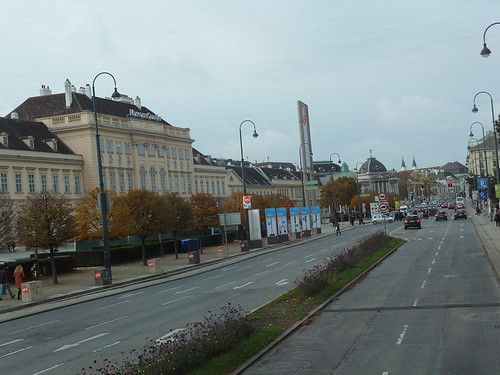 Museumsplatz on the Museums Quarter.
Museumsplatz on the Museums Quarter.
On our right lay the massive The Natural History Museum, facing the matching design of the Museum of Fine Art across the Maria-Theresien-Platz with its massive statue of the Empress Maria Theresia.
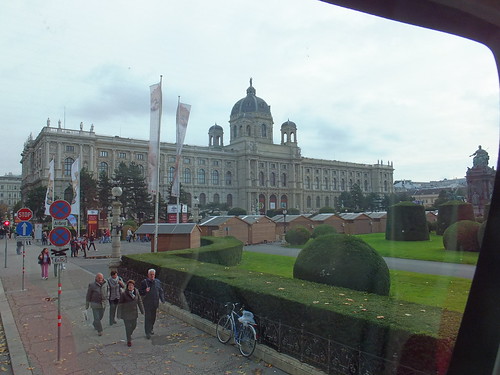 The Natural History Museum.
The Natural History Museum.
Our route took us back to the Ringstrasse at the section called Burgring (this time travelling anti-clockwise), where another stop was conveniently situated for the Museum of Fine Art, the Museum of Natural History, the Sissi Museum and the Hofburg. After a U-turn, we continued clockwise into Universitatsring. On our left, we passed the Austrian Parliament Building, in Greek Revival style, completed in 1883.
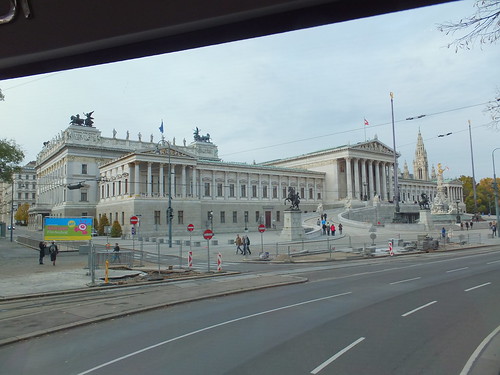 Austrian Parliament Building.
Austrian Parliament Building.
On our right lay the Burgtheatr, originally reserved for the nobility of Vienna. I discovered later that there's now a webcam on top of the building (which you can access here), offering a rather splendid panorama of the city.
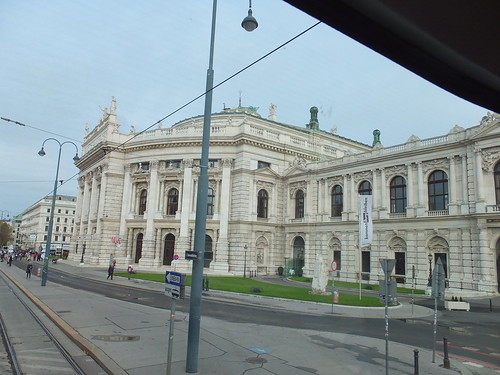 Burgtheatr.
Burgtheatr.
On our left, we passed the Rathaus (City Hall) and the main university building then we entered Schotten Ring, with the former Bourse on our right. Reaching the west bank of the Danube Canal, we turned south for a distance before taking a bridge over the canal.
 The Danube Canal viewed from Franz Josefs Kai.
The Danube Canal viewed from Franz Josefs Kai.
Next, the bus took us through the Karmeliter District with its market. The Welcome to Vienna site reports enthusiastically that "Interesting food and contemporary art are transforming the area around the Karmelitermarkt district market into one of Vienna’s most exciting neighborhoods". Our route continued past the park at Augarten where a massive anti-aircraft tower dominates the view.
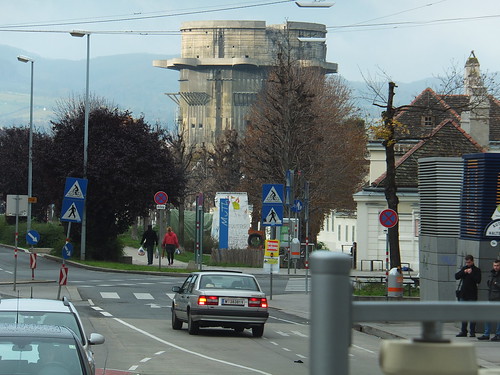 The World War II Flak Tower in the Augarten.
The World War II Flak Tower in the Augarten.
I'm afraid I was ignorant of the network of massive defensive structures erected in Vienna during World War II. The Vienna installations are described here and the Wikipedia article here also describes the Berlin and Hamburg installations.
Our route then passed the modern Praterstern railway station to reach the bus stop serving the famous Prater Park with its permanent fairground and historic Ferris Wheel, built in 1897. Originally there were 30 gondolas or cabins but when renovated after World War II, only 15 were provided. There's an excellent Wikipedia article here and the official site for the Wiener Riesenrad (Viennese Giant Wheel) is here.
 The Fairground and historic Ferris Wheel at the Prater.
The Fairground and historic Ferris Wheel at the Prater.
The bus made a U-turn and we returned to Praterstern station so as to reach Lassallestrasse and the Reichsbruke which would take us over the River Danube. This is regarded as Vienna's most famous bridge. The present bridge is the third: the first was built in 1872, the second in 1934. Despite renovations carried out between 1948 and 1952, the bridge collaped without warning in 1956 (with one fatality). The present bridge was opened in 1980. There's more in the Wikipedia article Reichsbrucke.
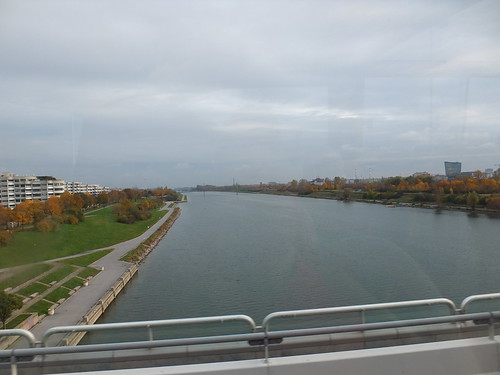 View from the Reichsbruke Bridge over the Danube, looking south-east.
View from the Reichsbruke Bridge over the Danube, looking south-east.
The Danube had always been subject to flooding so, in the 1970s, a relief channel was provided to the east of the main river, separated by a narrow strip of land. Better flood control has allowed additional areas near the river to be developed. There is now a modern city here - Donau City (or Vienna DC) - with suitably modern architecture. Since the United Nations has headquartered a number of its organisations and agencies here (there's a list on Wikipedia here), the area is also called 'UNO City'. All this development was triggered by the Vienna International Garden Festival held in 1964 on reclaimed land in between the Danube and the Old Danube (now used for recreation) to the east. The Danube Tower or Donauturm was built in connection with the Garden Festival and the tower and the surrounding Donaupark is a popular attraction for both residents and visitors. The official website for the tower is here.
 Donauturm (Danube Tower).
Donauturm (Danube Tower).
After a brief stop near the Old Danube, our bus turned back towards the city and re-crossed the Reichsbruke. A detour took us to a stop by the river, allowing passengers access the river cruise boats, Mexicoplatz or the Church of St. Francis of Assisi, built 1898.
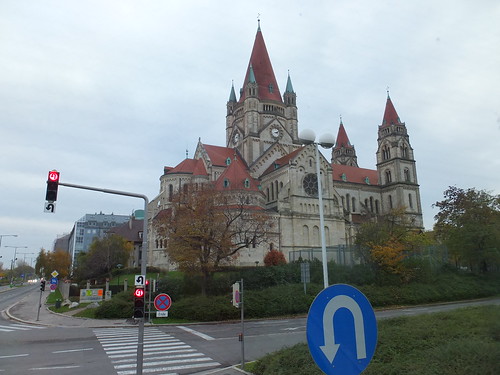 The Church of St. Francis of Assisi on Mexicoplatz.
The Church of St. Francis of Assisi on Mexicoplatz.
We continued past Praterstern station and paused near the Danube Canal, for connection to the canal cruise boats and other features such as Urania. In Greek mythology, Urania, daughter of Zeus was "the muse of astronomy". A few minutes later we passed the rather odd-looking building, topped with an astronomical observatory, which carries her name. Urania was built in 1910 as an educational establishment but was severely damaged during World War II. The restoration has included a cinema, puppet theatre and restaurant.
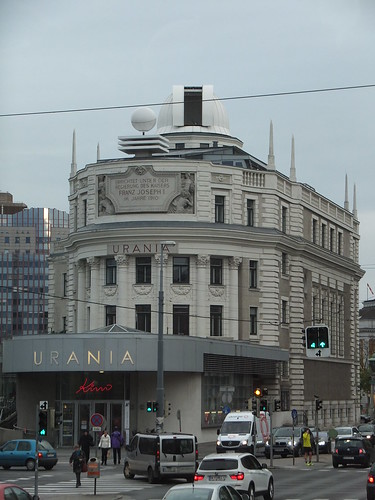
Urania.
A distinctive brick and stone building on our left was the Museum of Applied Arts, usually called 'MAK'. The museum's suitably 'arty' site is here.
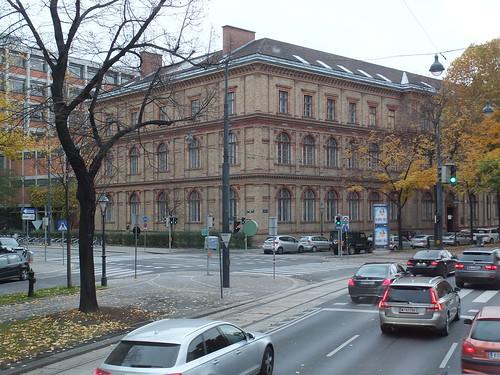 Part of the Museum of Applied Art.
Part of the Museum of Applied Art.
Also on our left, we passed the green gardens of the Stadtpark, which has a famous, gold-coloured statue of Johann Strauss. Soon, the now-familiar sight of the Opera House appeared and two right turns took our bus back to our starting point after a fascinating tour of the city. It didn't take long for Rita and I to walk back to our hotel.
We'd not quite finished for the day. On our way back to the hotel, we'd noticed a small 'Christmas Market' so we decided to make a final 'foray' to examine this before dining. Near the Opera House, a wide pedestrian passage between two blocks of upmarket shops had been provided with permanent roofing forming the 'Ringstrassen Galerien' suitable for short-lived events. From the 6th to the 9th November, this covered space was hosting 'Salzkammergut Advent', with rows of stalls provided with the 'posh garden sheds' now commonplace at Christmas Markets. This event was clearly not a 'standard' event but I didn't fully work it out until later. One or two stalls were selling (or offering tastes of) various foods and wines, one or two were selling craft items. But many of the stalls had posters showing winter sports and skiing and a number were showing videos of winter sports. One stall even had a large mock-up of a cable car cabin in which people could sit. But most of the stalls were selling Gluhwein, a mulled wine traditional in Austria around Christmas (there's a recipe here), served in pottery mugs printed with a suitable Salzkammergut picture, forming a souvenir of the event. All of the stalls seemed to be doing a good trade and the atmosphere was very convivial, assisted by a brass band. Salzkammergut, I later discovered, is a mountainous area of Austria near Germany, famous for skiing and winter sports. There's a tradition of spending the Advent period holidaying there so I presumed the event was a marketing exercise encouraging people to book holidays.
After Rita had made some purchases from a craft stall, we returned to our hotel for a meal after a stimulating, if exhausting, day.
 The band at the 'Salzkammergut Advent' market.
The band at the 'Salzkammergut Advent' market.
Related posts on this website
A Weekend in Vienna (Part 1).
A Weekend in Vienna (Part 2).
A Weekend in Vienna (Part 4).
A Weekend in Vienna (Part 5).
Books
[1] 'Imperial Vienna' by Lina Schnorr, published by H.B. Medienvertrieb GesmbH (ISBN: 978-3-9502396-9-0).
[2] 'Vienna: Art and Architecture', by various authors, published by h.f. ullmann (ISBN 978-3-8331-6006-6).
My Pictures
Click on any picture above for an uncropped view or search the albums below for pictures at different resolutions which may be downloaded for non-commercial purposes.
The albums below relate to this post:-
'Red Route' City Tour.
Wien, Austria.
The collection below includes all the albums on the Vienna trip:-
Austria.
